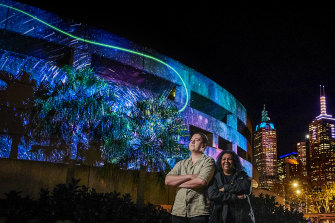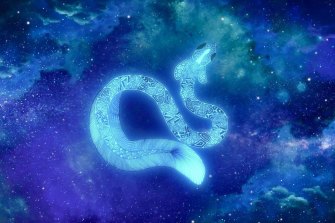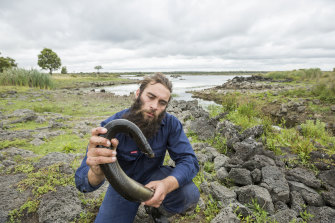Hamer’s odyssey: Voyage of an eel lights up Melbourne landmark
What sets the freshwater adult eel off on its northerly migration remains a mystery, but it covers thousands of kilometres of ocean over the course of a year, up the east coast to somewhere off the coast of Cape York, between Papua New Guinea and New Caledonia.
In an unknown location there, around what is presumed to be a submerged mountain deep below the Coral Sea, the adult ‘silver eels’ converge in large numbers to spawn and die. Ocean currents carry their larvae back to the continental shelf where, more than a year later, the larval eels become ‘glass eels’.

The installation provides First Nations communities with a new connection to the Hamer Hall site, honouring their unique connection to the land and giving greater visibility to their cultural heritage.Credit: Eugene Hyland
Tides and currents then convey these transparent eels back to the coastline, into southern coastal estuaries, where they metamorphose again, this time into ‘elvers’ that travel upstream, and even over land, to occupy fresh waterways for up to three decades until they embark on their own fateful return pilgrimage to the tropics.
This mysterious odyssey of the eel – or iilk – as it crosses land, river and sea, taking on many forms on its path to maturity, is depicted in a new digital artwork projected onto one of Melbourne’s landmark cultural centres.
Ancestral Memory was created by First Nations interdisciplinary artist Mutti Mutti/Yorta Yorta/Boon Wurrung/Wamba Wamba woman Maree Clarke and her nephew, Boon Wurrung/Barkindji emerging artist Mitch Mahoney.
“The work really touches on the idea of passing down intergenerational memory between parents, their offspring and the generation to come,” said Mahoney, who describes his art as a revitalisation and celebration of south-eastern Aboriginal culture.
The projected digital animation unfolds into different iterations of the Spirit Eel as it weaves around the curved facade of Hamer Hall on Melbourne’s Southbank.
“Both Mitch [Mahoney] and I are super excited that so many people are going to see it this time around. Especially for young ones to see work on this scale that you can dream as big as you can dream, and it can end up somewhere like Hamer Hall. I love that!” Clarke said.
The projection was part of Rising’s inaugural 2021 program, but its first unveiling was marred when the entire festival was cancelled on the eve of its launch due to the pandemic. This year, the light installation will return almost three weeks after the festival, which officially ended on Sunday.
The projection will begin next month between sunset and midnight and continue throughout July.

The physical manifestation of the Spirit Eel in Ancestral Memory was created by First Nations interdisciplinary artists Maree Clarke and Mitch Mahoney.Credit:Rising
For millennia, eels provided a valuable resource for First Nations peoples located in south-east Australia, including the Birrarung and Maribyrnong River systems upon which Melbourne sits.
Archeological evidence of the construction of sophisticated systems to farm and preserve eel in Victoria’s south-west region provides a glimpse of the eel’s economic significance to First Peoples of the south-east.
The ancient aquaculture systems of the Gunditjmara people that comprise the Budj Bim cultural landscape, around 40 kilometres north of Portland in the state’s south-west, were recognised by UNESCO in 2019 as a world heritage site.

Indigenous ranger Aaron Morgan is among the new generation of Gunditjmara people caring for Budj Bim landscape and its network of ancient weirs and eel traps. Credit:Rodney Dekker
The constructed rock weirs and channels across the landscape have been identified as being at least 6,600 years old and remain in use today.
Evidence of smoking preservation techniques has also been recorded. Oral histories record the trading of preserved eels over vast distances with First Nations peoples in far-west Queensland.
Budj Bim is the only Australian world heritage site listed solely for its Aboriginal cultural values and just the second site in Victoria to achieve a world heritage listing, after the site of the Royal Exhibition Building and its surrounding Carlton Gardens was listed in 2004.
For the peoples of the Kulin Nation – lands that encompass the site of the greater city of Melbourne – the eel is a protector spirit, as well as a food source, and a seasonal marker and timekeeper.
The metaphor of the Spirit Eel connects time and place and represents a story of resilience and adaptation that has been pushed below the surface but never lost, said the artists.
A cultural guide to going out and loving your city. Sign up to our Culture Fix newsletter here.